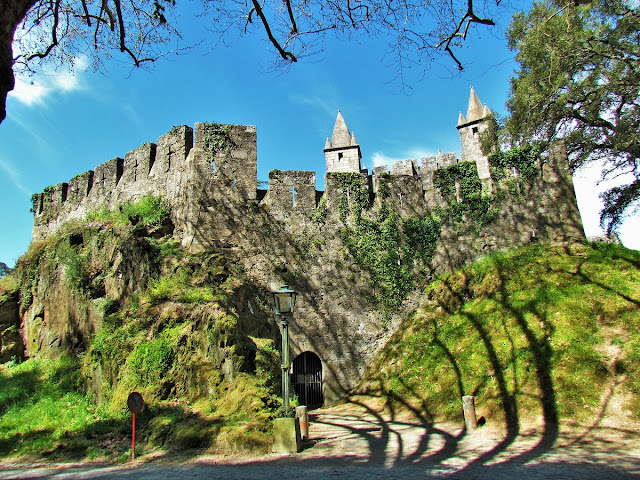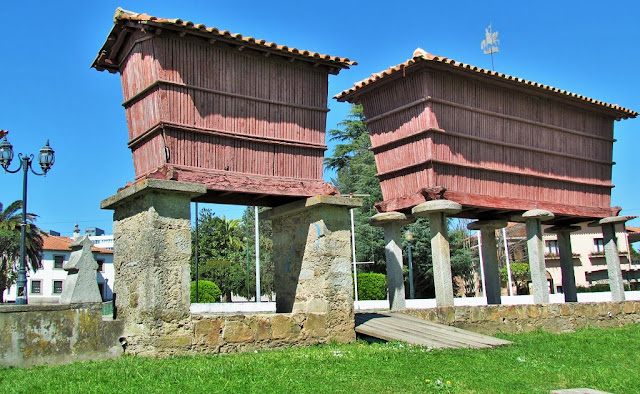SANTA MARIA DA FEIRA
N 40.92538; W 8.54230
Santa Maria da Feira is a city and a municipality in Aveiro District in Portugal, 23 km from central Porto. The population in 2011 was 139,309, in an area of 215.88 km².
Santa Maria da Feira is a heavily industrialized municipality and is famous for its several cork transforming and shoe factories. The seat of the municipality is Feira, famous for its medieval castle which was the residence of Portugal's first king, Afonso Henriques, for a short period of time. The castle, located at the top of a hill, was of considerable strategic importance during its time.
Every year, in summer, a medieval festival takes place in Santa Maria da Feira - the Viagem Medieval - during which the city goes back to the Middle Ages.
The municipality's sights include the Convento do Espírito Santo (convent), the Igreja da Misericórdia (church; 18th century), and the Rua Direita (street; 18th and 19th century architecture). However, its greatest landmark is the castelo Santa Maria da Feira Castle, from the 11th century.
The Parque das Ribeiras do Uíma extends over an area of about six hectares, which combines various systems of wetlands, land and human occupation forming an extensive floodplain. Located in a valley between the villages of Fiães and Lobão, it is characterized by the extensive swampy forest of alders and willow forests. Here you can see very rich spaces in terms of habitat diversity, housing a large number of plant and animal species.
With the enhancement of the banks of the River Uíma, namely with interventions for the preservation of biodiversity and conservation of the ecological corridor, conditions were created to observe the natural habitats closely.
It is possible in this space to take footpaths, with an extension of about 2 km, with interpretation of riverside ecosystems with protection status, and to observe the cycles of annual transformations in a harmonious balance between natural conditions and humanized systems.
More information:
With the enhancement of the banks of the River Uíma, namely with interventions for the preservation of biodiversity and conservation of the ecological corridor, conditions were created to observe the natural habitats closely.
It is possible in this space to take footpaths, with an extension of about 2 km, with interpretation of riverside ecosystems with protection status, and to observe the cycles of annual transformations in a harmonious balance between natural conditions and humanized systems.
More information:
www.rio-uima.pt

516 Arouca Bridge + Paiva Walkways;
Águeda;
Aguada de Baixo;
Albergaria-a-Velha;
Alvarenga + Paradinha;
Anadia;
Arões + Trebilhadouro;
Arouca + Meitriz;
Arouca Unesco Global Geopark;
Avanca;
AVEIRO;
Bussaco;
Castelo de Paiva;
Cortegaça;
Costa Nova;
Covelo de Paivó + Janarde + Drave;
Curia;
Esmoriz;
Estarreja;
Espinho;
Fábrica da Vista Alegre;
Freita Mountain (Serra da Freita);
Ílhavo;
Mealhada;
Murtosa;
💓💓💓💓💓
SEARCH IN ALPHABETICAL ORDER
IN THE DISTRICT OF AVEIRO

Águeda;
Aguada de Baixo;
Albergaria-a-Velha;
Alvarenga + Paradinha;
Anadia;
Arões + Trebilhadouro;
Arouca + Meitriz;
Arouca Unesco Global Geopark;
Avanca;
AVEIRO;
Bussaco;
Castelo de Paiva;
Cortegaça;
Costa Nova;
Covelo de Paivó + Janarde + Drave;
Curia;
Esmoriz;
Estarreja;
Espinho;
Fábrica da Vista Alegre;
Freita Mountain (Serra da Freita);
Ílhavo;
Mealhada;
Murtosa;
Luso;
Oiã (Oliveira do Bairro);
Oliveira de Azeméis;
Oliveira do Bairro;
Ovar;
Palhaça (Aveiro);
Paramos;
Pateira de Fermentelos;
Praia da Barra;
Praia da Vagueira;
Ria de Aveiro;
Salreu;
Sangalhos;
Santa Maria da Feira;
São João da Madeira;
Sever do Vouga;
Silvalde;
Sosa (Vagos);
Vagos;
Vale de Cambra;
Válega;
Oliveira de Azeméis;
Oliveira do Bairro;
Ovar;
Palhaça (Aveiro);
Paramos;
Pateira de Fermentelos;
Praia da Barra;
Praia da Vagueira;
Ria de Aveiro;
Salreu;
Sangalhos;
Santa Maria da Feira;
São João da Madeira;
Sever do Vouga;
Silvalde;
Sosa (Vagos);
Vagos;
Vale de Cambra;
Válega;
Return to mainland Portugal &
the Azores and Madeira islands





























































